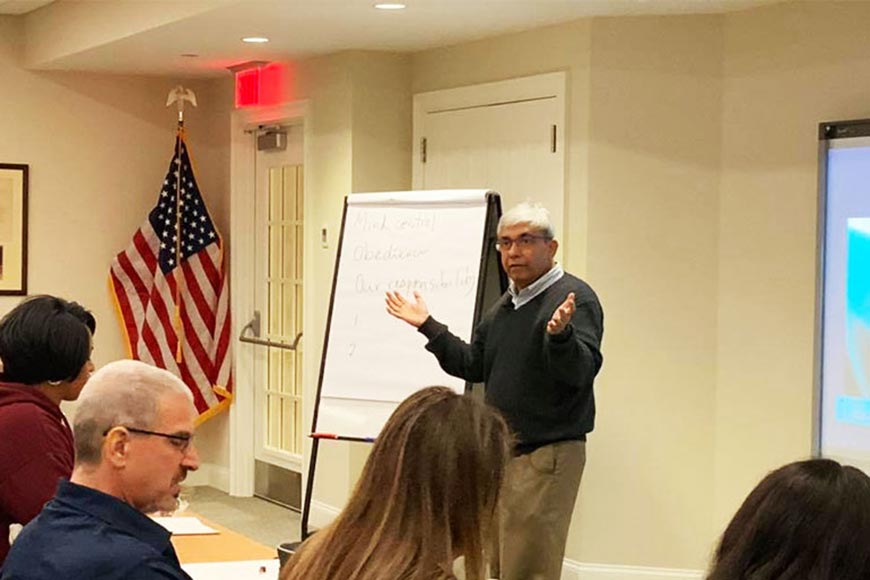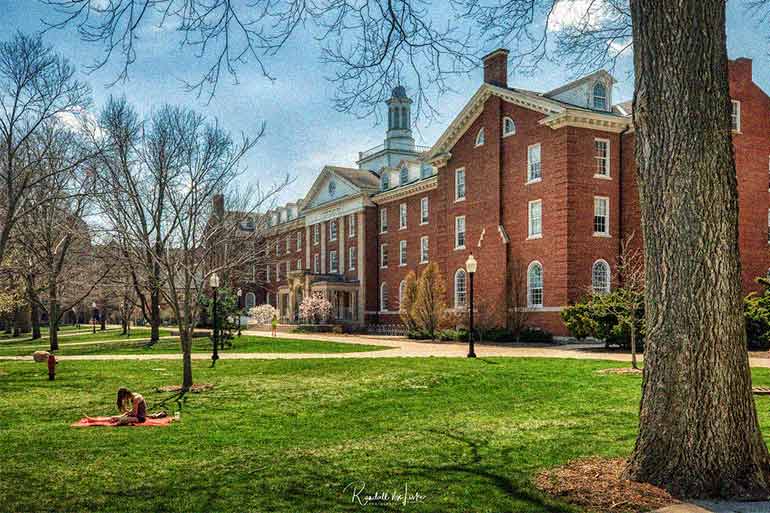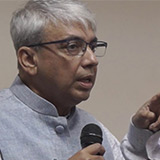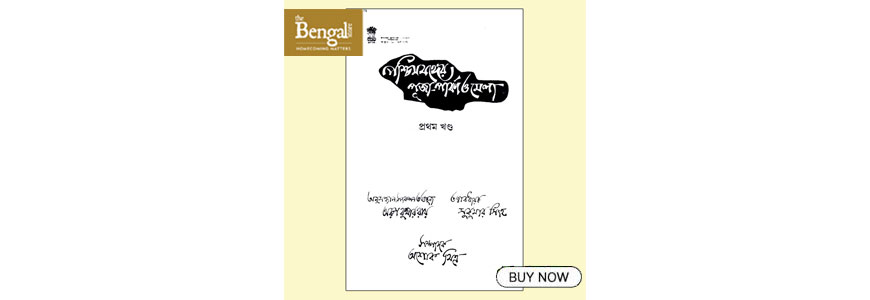Mericamaya Satkahan: Living in the USA…on $380 a month

Dr. Partha Banerjee is speaking on labour education
A year after I set foot in Illinois State University (ISU) in the American Midwest in 1985, Mukti joined me in August 1986, as a result of sustained efforts, a slew of permissions, and signing endless bits of paper. By then, I was simply unable to live alone any longer. Thankfully, I did have some pleasant company thanks to Biswada from Chicago, his wife Rebecca Boudi, and their two young daughters.
It had been seven years since cancer had taken my mother from us, in a matter of months. Had she lived, I don’t know if things would have been any different. All in all, I have a feeling she would not have stopped me. She very well knew how single-minded I could be, and the heights I aspired to. She knew of my stubbornness, of my determination to finish anything I started.
But as I say, she did not live long enough to put this to the test. My father did. And he was delighted when my I-20 immigration documents arrived from ISU. These were the papers that would get me an F-1 visa from the US Consulate in Kolkata. Because I was already teaching in a college, which had granted me a mere two years’ leave of absence to obtain a Masters degree, and because I was leaving my wife behind, the Consulate could have no doubt that I was not going to stay on in the USA, having sneaked in as a student. Ergo, getting a US visa would be a cakewalk.
Is it even possible to live for a month on $380 in the USA? Even if my education was paid for. House rent, books and stationery, food - how could I budget for all this on just $380? And the rules forbade us from accepting any work outside the department or university. But we simply did not know how much they were paying mainstream Americans vis-a-vis us foreign students.
And it was. In a matter of 10 days, or a fortnight at most, I had packed my bags and landed in the USA, leaving India, leaving Bengal, behind. there had simply been no time to look back, or reconsider, or even discuss the future with anyone. I was so happy, so proud, so excited to have won a scholarship to study in the US, that it did not occur to me to think things through.
The only slight resistance came from my in-laws, a family blessed with a great deal of pragmatism. They were also a family of Communists, and hence opposed to all things American, but that wasn’t the reason for their misgivings about my chasing academic success in a foreign land. Mukti’s mother in particular was tearful at the idea of her only child moving so far away, a child who had brought with her a new dawn of hope after the agonising years of Partition, riots, fleeing to Kolkata from Dhaka as refugees, and battling grinding poverty to get back on their feet. She had built a new life with her husband and daughter. Now, that daughter was going off to the other end of the world, and she couldn’t process the idea. Mukti’s father was far more stoical, restrained, willing to sacrifice his feelings at the altar of the aspirations of his daughter and son-in-law.
What I had absolutely failed to understand was how the US education system - whose backbone is formed by foreign students - could financially exploit someone like me, buying my labour for a pittance. I was to receive $380 per month as an assistantship, though I paid no student fees. My job was to take practical classes for undergraduates, to which end I would be working 20 hours a week, or 80 hours a month. Now divide 380 by 80 and see how absurd the result is. A senior student in the field of higher education was not even making five dollars an hour! Where even the man who cut the grass on your lawn would agree to nothing less than 10 dollars. But we were foreign students, hence easy to fool. Because we knew nothing, least of all the US economy.
I used to be a professor, cocooned in the respect of my pupils. But I was now merely a nameless foreign student.
Is it even possible to live for a month on $380 in the USA? Even if my education was paid for. House rent, books and stationery, food - how could I budget for all this on just $380? And the rules forbade us from accepting any work outside the department or university. But we simply did not know how much they were paying mainstream Americans vis-a-vis us foreign students. Brand new arrivals like me were even easier to fool, consumed with joy as we were at the very idea of studying in America. As though we had won the lottery. So insufferably proud of ourselves.
 Illinois State University
Illinois State University
Illinois State University, Normal town. About 100 miles from the legendary Chicago, in central Illinois. As Rabindranath Tagore wrote in the poem Birpurush, “ধূ ধূ করে যেদিকপানে চাই, কোনোখানে জনমানব নাই (emptiness as far as I can see/ not a soul to be found near me…”) Certainly not a Bengal soul. The cornfields of the midwest form the breadbasket of the USA. Roads make their timid way through the endless stretches of corn, with the occasional town dotting the landscape - Normal-Bloomington, Urbana-Champaign, Peoria and, a little further in, the state capital Springfield, a small town made memorable by its association with Abraham Lincoln.
What I had absolutely failed to understand was how the US education system - whose backbone is formed by foreign students - could financially exploit someone like me, buying my labour for a pittance. I was to receive $380 per month as an assistantship, though I paid no student fees. My job was to take practical classes for undergraduates, to which end I would be working 20 hours a week, or 80 hours a month.
Much, much farther south, nearly 300 miles away, is the Southern Illinois University (SIU) town of Carbondale. Having completed my Masters at ISU, I made my way to SIU for my PhD. But that is a story for another day.
What icy winters Illinois has! A blanket of snow all around. To the south of Chicago is the suburb town of Lisle, and at the other end is the medium-sized city of Naperville, where Gujarati Indians live among Americans. Lisle, a sleepy little settlement, is where Biswada - who local Indians call Bob Uncle - lives in his single-storey home, on a lonely stretch of road known as North Clover Drive. My visits to the home usually last a day or two. I hop on to the bus called Peoria Charter, from in front of our library, and pay 10 dollars for the two-hour ride. Biswada picks me up in the family Buick from the bus stop.
Their little home seems cloaked in affection. In the middle of the small backyard stands a huge maple tree, like the resident sentinel. A thick layer of snow surrounds the home. The heater buzzes from inside the house. All the doors and windows are closed against the icy cold. The uncarpeted bit of blue mosaic bathroom floor - Bengalis don’t have carpets in bathrooms; we spill water, and mop it up - strikes the feet like a block of solid ice. The absence of fresh air creates an odd smell. I’ve never felt it in my country. Or in Kolkata. But I smelled it the moment I stepped into our student apartment in Normal, particularly in the underground basement. Sunlight never has, and never will find its way here. The damp, oppressive smell emanates from the carpet and wallpaper. When it meets the strong chemical aroma of the carpet cleaner, the combination is stifling. Coming from Bengal, the land of fresh air, this oppressive atmosphere seems like a prison.
(To be continued…)











